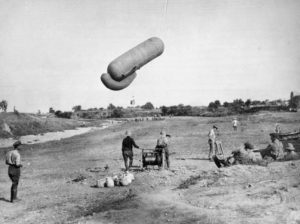Monday June 3rd, 1918
Breakfast 7am. Cookhouse for one hour. No guard today. Very hot, washed clothes. 27th Kite Balloon Section, Royal Flying Corps. Went to 22nd Divisional Concert Hall and met Joe Cheetham of Shaw. Enjoyed the concert fine. General Milne there. Came back in aircraft tender 11:30.
Kite Balloon Sections (KBS)
By the time Frank arrived at the 27th KBS they would have been part of the recently formed RAF and not the RFC. It is unclear where Frank is exactly but it sounds like he is on a lake – as later today he is transported by aircraft tender. This would make sense as a KBS would need access to a lot of water to make hydrogen for the balloons.
Apparently a British KBS usually comprised about 150 to 200 people including about 5 or 6 officers. Each balloon required 48 highly trained men to handle it. In addition to the balloons there were winches and cables, the baskets, storage cylinders and the hydrogen gas production plant. The balloons sheer size made them awkward and filled with hydrogen gas, potentially lethal.¹
The 27th KBS

The 26th and 27th KBS arrived in February 1917, following the 17th which had arrived in September 1916. In early March 1917, suffering from heavy rain and then freezing temperatures and snow, the 27th were struggling to establish themselves. However by the end of the month, they were doing good work, helping the artillery to identify and attack targets, and observing enemy movements.
This made the balloon a prime target for enemy aircraft, as is apparent in the 27th KBS War Diary for May 1st 1917. Throughout the day dogfights between allied and enemy planes had been underway – one attacking and the other defending the balloon and then:
‘Shortly before 5 0’clock there they were again – two of them – with machine guns and tracer bullets, …. Our own machine gun was the first to start on the work of repelling the foe and then the Archies³ weighed in. Three times did the first plane assault the balloon, each time unsuccessfully , and then he sheered off and stood by while the other plane continued the attack. Along he came spitting out death and destruction, till he was about fifty yards from the balloon. Then all of a sudden his tail and part of one main plane flew off, while the rest of the machine just crumpled up, and down he came like a stone. Apparently two of our AA had simultaneously scored a direct hits – one on the tail, the other the wing. As the machine hit the ground it burst into flames, and continued blazing while there was anything combustible about it.‘²
Concert Party
All the excitement of guarding a balloon is ahead of Frank. Instead tonight he enjoys a concert party in the company of the great and the good.
13th (Service) Battalion War Diary – 3rd June 1918 – Tertre Vert
In accordance with Operation Order No 38, the Battalion marched to La Marraine in the evening, the 8th KSLI moving into Tertre Vert on being relieved by the 65th Infantry Brigade in No 3 Sector. The 66th Infantry Brigade is now situated as under:- 8th KSLI at Tertre Vert, 9th South Lancs at Moravca, 12th Cheshire at Irikli, 13th Manchesters at La Marraine and Brigade HQ at Buck Hill.
References & Further Reading
¹ ‘Kite Balloons at Salonika‘ thread on the Great War Forum
* HU 81881, copyright IWM. Image taken from ¹ as unavailable on IWM at present.
² ‘The Salonika Front‘ painted by William T Wood RWS & described by AJ Mann MA (Captain & recording officer 22 Balloon Company). Extract from the 27th KBS War Diaries, page 176/177.
³ ‘Archie and Archies’ – war-time slang for Anti-Aircraft guns and gun fire.
Diary of Harry J.E. Burtenshaw‘, 45040, 27 Kite Balloon Section,Royal Flying Corp ( B. 21stNovember 1878 -D. 13thMarch 1956) Aug 1916 to June 1918 (invalided home with malaria)
‘Hydrogen for Airships’ (article courtesy AM Burgess and Cleveland Industrial Archeaology Society)


